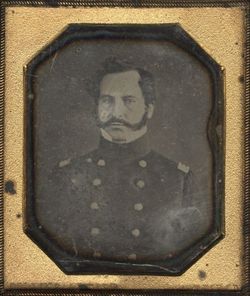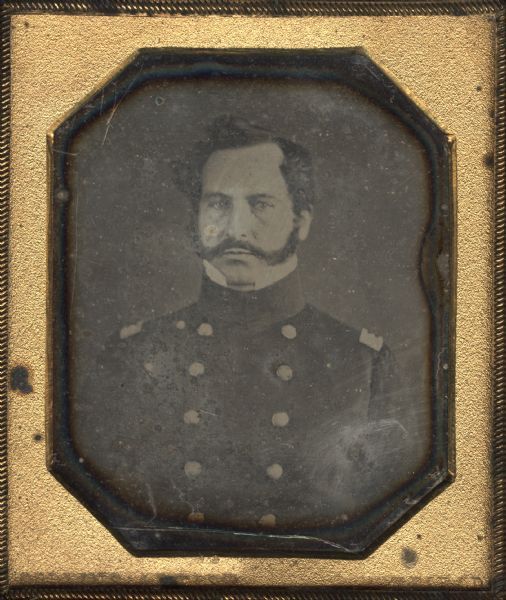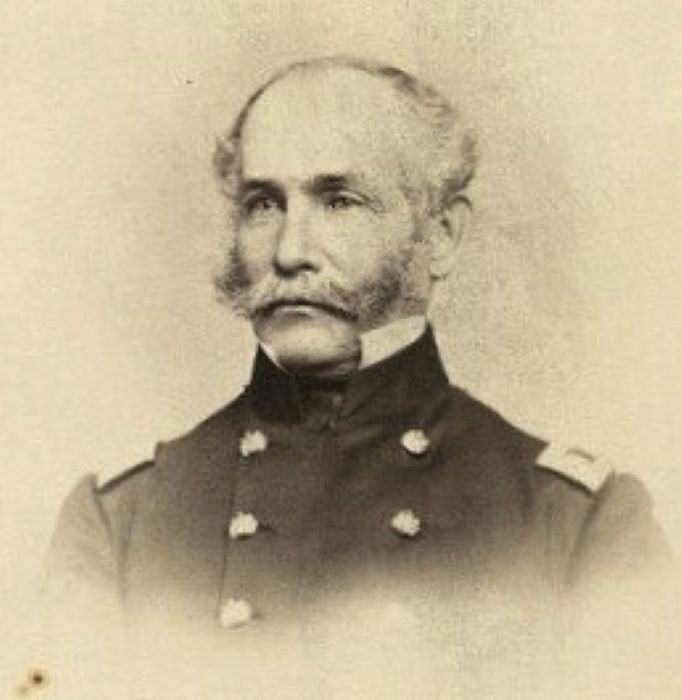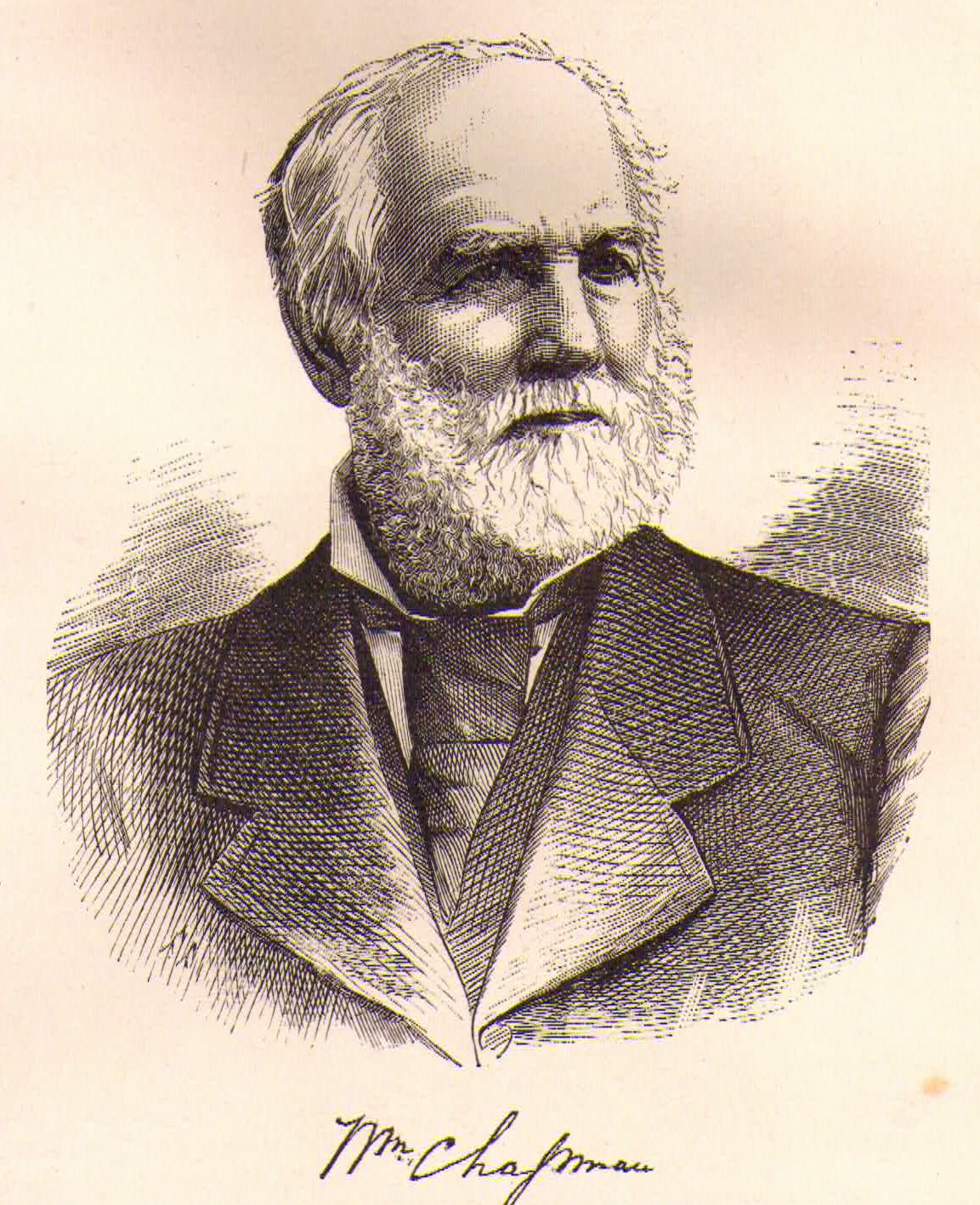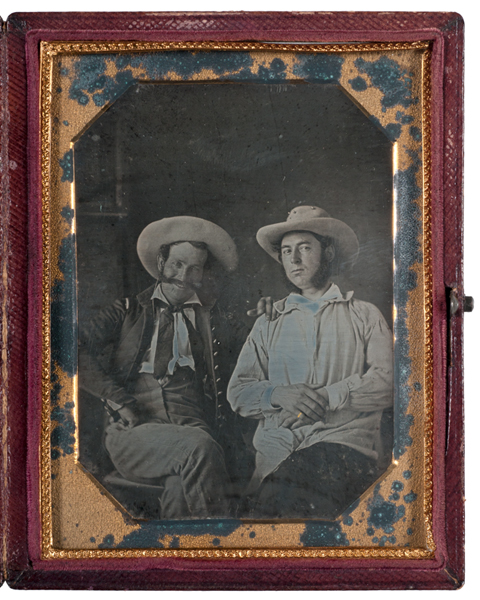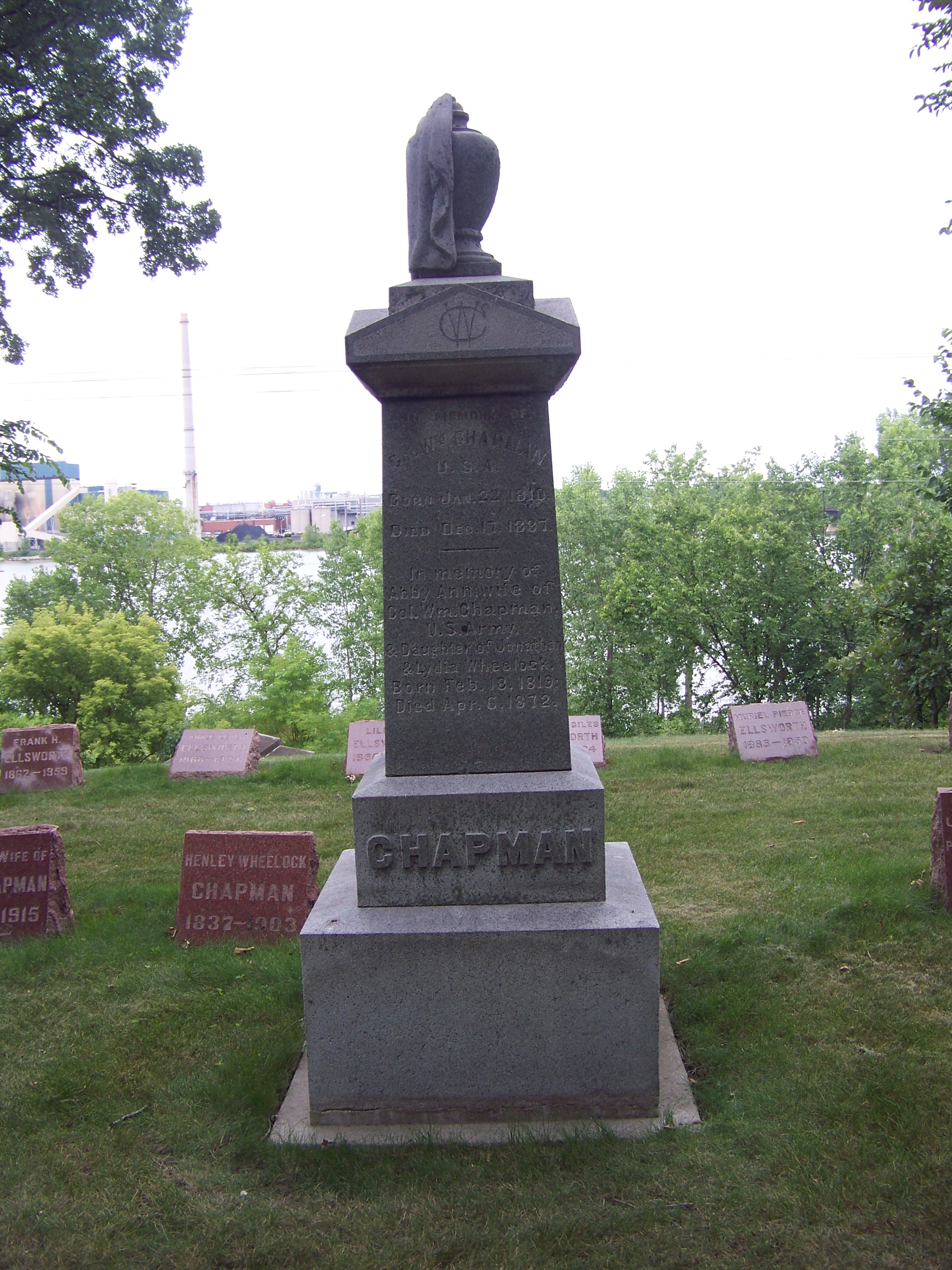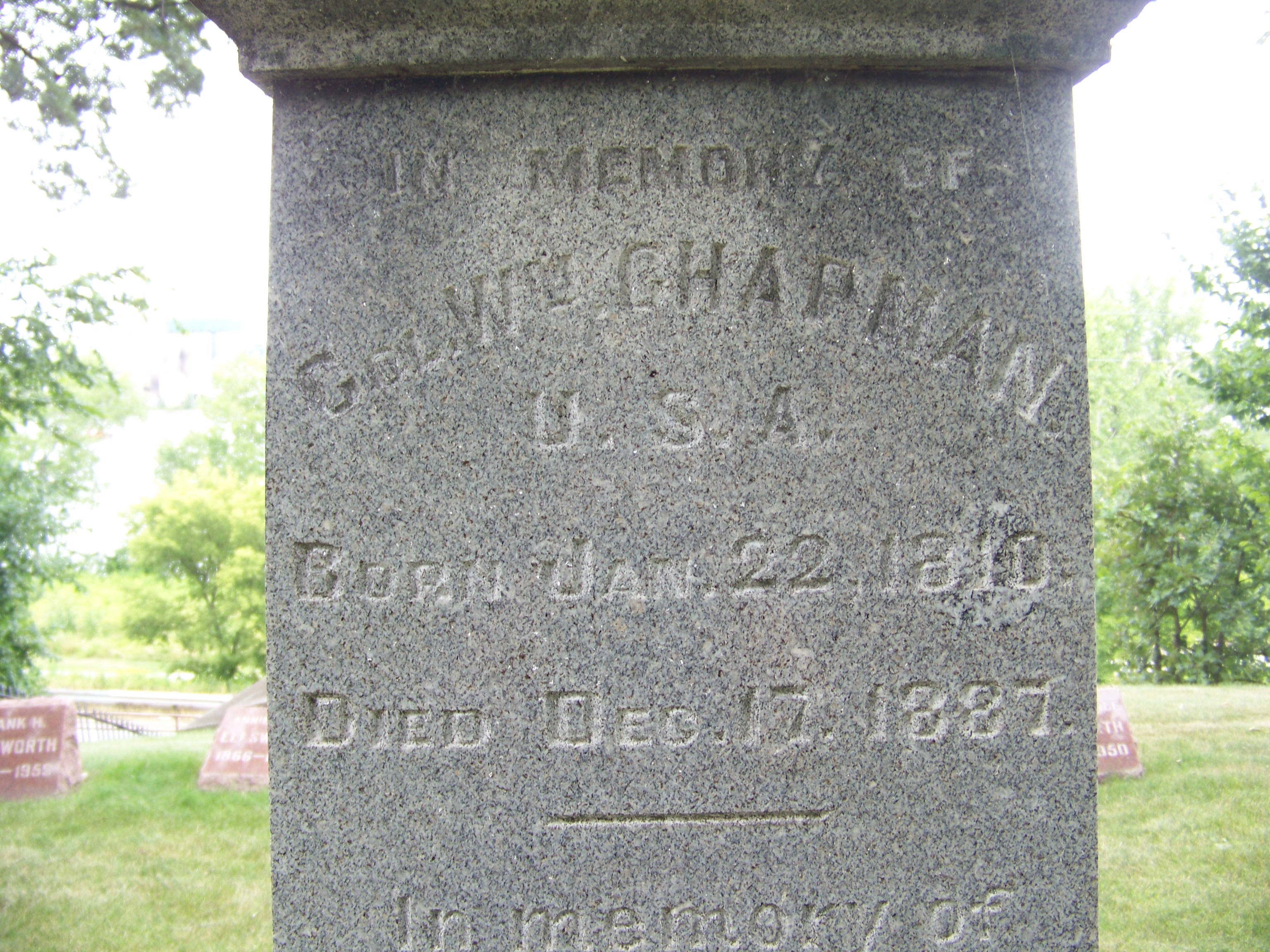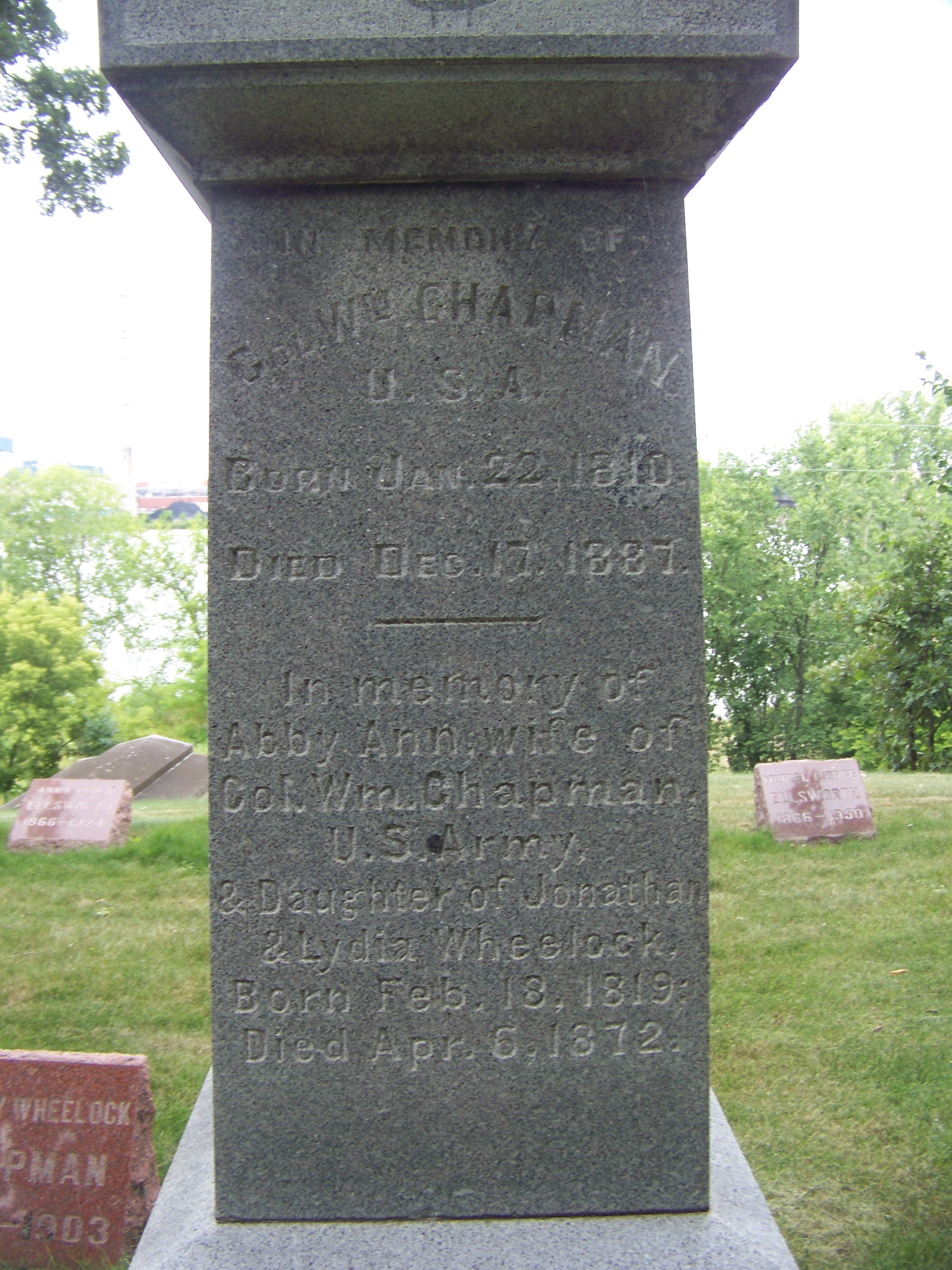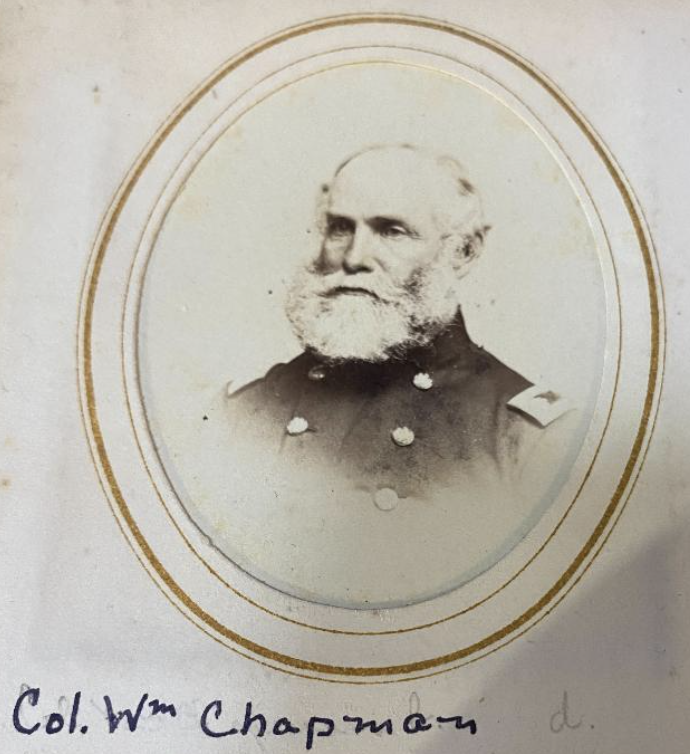USMA CLASS OF 1831
CULLUM'S REGISTER # 643
VETERAN, BLACK HAWK WAR - 1832
VETERAN, MEXICAN WAR - 1846-48
BREVET MAJOR, LT. COL. FOR CONDUCT IN MEX. WAR
UTAH EXPEDITION - 1857-60
CONSTRUCTED FORT UNION, N.M.- 1861
LT. COLONEL, 3RD INFANTRY- 1862-63
SERVED, ARMY OF THE POTOMAC, TWO YEARS
BRIGADE CMDR, 5TH ARMY CORP
BREVET COLONEL, SECOND BULL RUN - 1862
RETIRED DUE TO DISEASE AND INJURY - 1863
SPECIAL ARMY DUTY - 1863-65
++++++++++++++++++++++++++++++++++++
643. ( Born Md. ). WILLIAM CHAPMAN. ( Ap'd Md. ). 15
( BORN JAN. 22, 1810, ST. JOHN'S , CHARLES CO., MD )
Military History : --- Cadet at the Military Academy, July 1, 1827 to July 1, 1831, when he was graduated and promoted in the Army to
( BVT. SECOND LIEUT., 5TH INFANTRY, JULY 1, 1831 )
Served: on frontier duty at Ft. Mackinac, Mich., 1831-32, --- on the "Black Hawk Expedition ", 1832, but not at the seat of war, at the Military Academy, as Asst. Instructor of Infantry Tactics, Oct. 20, 1832, to June 29, 1833, on frontier duty at Ft. Howard, Wis., 1833 ; as Adjutant
( SECOND LIEUT., 5TH INFANTRY, MAR. 4, 1833 )
5th Infantry ; at Regimental Headquarters, Nov. 7, 1833 to July 1, 1838 ; on Recruiting service, 1838-40 ; on frontier duty at Ft. Snelling,
( FIRST LIEUT., 5TH INFANTRY, DEC. 31, 1836 )
Min., 1840-41 --- and Ft. Mackinac, Mich., 1841-42, 1842-45 ; in Military Occupation of Texas, 1845-46; in the War with Mexico, 1846-48
( CAPTAIN, 5TH INFANTRY, JUNE 8, 1845 )
being engaged in the Battle of Palo Alto, May 8, 1846, --- Battle of Reseca-de-la-Palma, May 9, 1846, --- Battle of Monterey, Sep. 21-23, 1846, --- Siege of Vera Cruz, Mar. 9-29, 1847, --- Capture of San Antonio, Aug. 20, 1847, where he was wounded, --- Battle of Churubusco, Aug. 20,
( BVT. MAJOR, AUG. 20, 1847, FOR GALLANT AND MERITORIOUS CONDUCT
IN THE BATTLE OF CONTRERAS AND CHURBUSCO, MEX. )
1847, --- Battle of Molino del Rey, Sep. 8, 1847, --- Storming of Chapultepec, Sep. 13, 1847, --- and assault and capture of the City of Mexico,
( BVT. LIEUT. COL., SEP. 8, 1847, FOR GALLANT AND MERITORIOUS CONDUCT
IN THE BATTLE OF MOLINO del REY, MEX. )
Sep. 13-14, 1847 ; in garrison at Ft. Columbus, N. Y., 1848-49 ; on frontier duty at Ft. Gibson, I. T., 1849-51, --- conducting recruits to Texas, 1851, --- Clear Fork of the Brazos, Tex., 1851-53, --- Ringgold Barracks, Tex., 1854-55, --- March to Eagle Pass, Tex., 1855-56, --- and Ringgold Barracks, Tex., 1856=57 ; in Florida Hostilities against the Seminole Indians, 1857 ; and on frontier duty on Utah Expedition, 1857-58, 1859-60, --- March to New Mexico, 1860, --- at Ft. Bliss, Tex., 1860-61, ---
( MAJOR, 3D INFANTRY, FEB. 25, 1861 )
Ft. Fauntleroy, N. M., 1861, --- and Ft. Union, N. M., 1861. ****
Served during the Rebellion of the Seceding States, 1862-66 : in command of regiment in the defenses of Washington D. C. , Jan. - Mar., 1862.
( LIEUT. - COLONEL, 3D INFANTRY, FEB. 20, 1862 )
in the Virginia Peninsular Campaign ( Army of the Potomac ), Mar. - Aug., 1862, being engaged in the Siege of Yorktown, Apr. 5 - May 4, 1862, --- Battle of Malvern Hill, July 1, 1862, --- and Skirmish at Harrison's Landing, July 2, 1862 ; in Northern Virginia Campaign, Aug. - Sep. , 1862,#### being engaged in the Battle of Manassas, Aug. 30, 1862 ; on sick leave
( BVT. COLONEL, AUG. 30, 1862
FOR GALLANT AND MERITORIOUS SERVICES AT THE SECOND BATTLE OF BULL RUN, VA. )
of absence, Sep. 20, 1862 to Dec. 3, 1863, in command of Draft Rendezvous at Madison, Wis., Dec 3, 1863 to Feb. 28, 1865 ; on special duty
( RETIRED FROM ACTIVE SERVICE, AUG. 26, 1863, FOR DISABILITY RESULTING FROM LONG AND FAITHFUL SERVICE, AND DISEASE CONTRACTED IN THE LINE OF DUTY. )
at Washington D. C., Feb. 28 to Sep. 11, 1865.
Served as Member of Board for Examination of Officers for Promotion in the Army, Oct. 1, 1866 to Jan. 9, 1867.
( DIED, DEC. 17, 1887, AT GREEN BAY, WIS., AGED 78 )
Buried Woodlawn Cemetery,
+++++++++++++++++++++
**** NOTE: Col. Chapman commanded at Fort Union from June 13 until December 13, 1861, when he went east to rejoin his regiment. During his period of command he rebuilt Fort Union, New Mexico in a more secure location than the first fort, away from some bluffs that had overlooked the first Fort Union.. His efforts at recruiting, construction, and securing the region and the Santa Fe Trail, went a long way toward the success of General Canby in the battles at Valverde and Glorieta Pass in the following year, battles which secured the New Mexico and Colorado Territories for the Union.
#### NOTE: Commanded the Second Brigade, Second Division of the Fifth Army Corp under Major General Fitz John Porter , at the 2nd Battle of Bull Run.
NOTE: William Chapman should not be confused with William W. ChApman, USMA Class of 1837, who served in the Seminole Wars, fought with Wool at Buena Vista, and garrisoned ten years in Texas, dying in 1859.
+++++++++++++++++++++++++++++++++++
Nineteenth Annual Reunion of the Association of the Graduates of the United States Military Academy, June 11, 1888
WILLIAM CHAPMAN
No. 643, Class of 1831
WILLIAM CHAPMAN, son of Major Henry Henley Chapman and Mary Davidson Chapman, was born at St. John's ( near Port Tobacco ), Charles County, Maryland on January 22, 1810. He sprang from good military stock, his father having been a revolutionary soldier and serving during the latter part of the conflict, having been at the age of nineteen a Lieutenant in Colonel Diges's regiment at the Battle of Yorktown. A certificate of his father's membership in the Society of the Cincinnati, an organization of the Continental Army, signed by George Washington as President, and General Henry Knox as secretary was cherished by Colonel Chapman until his death. The subject of this sketch received as academic education and in 1827 was appointed to a cadetship at the West Point Military Academy.
He entered West Point July 1, 1827, and was graduated July 1, 1831. He was made Brevet Second Lieutenant and assigned the Fifth Infantry. His first duty was at Fort Mackinac, 1831-32. He was on the Black Hawk Expedition in the latter year. His proficiency as a soldier is attested by the fact that in October, 1832 , he was appointed Instructor of tactics at West Point. He was promoted to Second Lieutenant Fifth Infantry March 4, 1833. In July , 1833, he was ordered to Fort Howard, his regiment ( the Fifth ) having come here in 1828. He was on November 7th appointed Adjutant at regimental headquarters , and continued as such until July, 1838. It was during this period that the then young Lieutenant formed the ties and attachment that hereto make him a permanent resident here. He married in 1836, Miss Wheelock, and they kept house in the fort until the regiment was ordered away. He was on recruiting service at Cumberland, Maryland from 1838 to 1840. He was made First Lieutenant Fifth Infantry December 31, 1836. In 1840-41 he was on duty at Fort Snelling. He was won't to recall the pleasant situation of that fort, and remembered that when he went there there was but one log shanty on the present site of St. Paul, which was then called Pig's Eye Village. Minneapolis was then undreamed of. He was returned to old Fort Mackinac, remaining there from 1841 to 1845. On June 8 of the latter year he was promoted to Captain Fifth Infantry. In 1845-46 during the military occupation of Texas, he was on duty there.
Then the chronicle carries his record into the Mexican War, where it is markedly conspicuous service, and in which he was associated with the gallant names of Merrill, Buchanan, Ringgold, May, Maloney and others whose valor was so fully attested. He was engaged the battles of Palo Alto, May 8, 1846 ; Reseca de la Palma, May 9, 1846 ; Monterey, September 21-23, 1846 ; Siege of Vera Cruz, March 9-29, 1847; capture of San Antonio, August 20, 1847 where he was wounded, battle of Cherubusco, August 20, 1847. On this latter date he was brevetted Major for gallant conduct in the battles of Contreras and Cherubusco. The exceedingly hot conflict of Molino del Rey, September 8, 1847, in which , after eight superior officers had been killed, he commanded his regiment; the storming of Chapultepec, September 13, 1847 ; and the crowning engagement, the assault and capture of the City of Mexico. He was brevetted Lieutenant-Colonel September 8, 1847, for gallant and meritorious conduct in the battle of Molino del Rey. He was in garrison at Fort Columbus, Governor's Island, New York, 1848-49, and on frontier duty at Fort Gibson, Indian Territory, 1849-50. In 1851 conducted recruits to Texas, stationed at Clear Fork of the Brazos , Texas, 1851-53 ; at Ringgold Barracks, Texas, 1854-55 ; marched to Eagle Pass, Texas, 1856, and back to Ringgold Barracks 1856-57. In 1857 he was engaged in operations in Florida against hostile Indians, and on frontier duty in Utah in 1857-58, 1859-60. While at the west he marched with commands twice from Fort Leavenworth, Kansas to Camp Douglass at Salt lake City, and twice back. In 1860 he marched from Salt Lake City to New Mexico. Stationed at Fort Bliss, Texas, 1860-61. Was promoted to Major, Second Infantry, February 25, 1861. After being stationed at Fort Fauntleroy, New Mexico, in 1861 he constructed Fort Union, New Mexico, where after its completion, he was stationed.
His active service in the war of the rebellion was with the Army the Potomac. In January and March was in command of regiment in defenses of Washington. February 20, 1862, he was promoted to Lieutenant-Colonel Third infantry. In the Virginia Peninsular Campaign from March to August 1862, being engaged in the siege of Yorktown, April 5 - May 4, 1862 ; battle of Malvern Hill, July 1, 1862; skirmish at Harrison's Landing, July 2, 1862 . In northern Virginia campaign , August-September, 1862 being engaged in the Battle of Manassas, August 30, 1862. He was brevetted Colonel for gallant and meritorious conduct at the latter and Second Battle of Bull Run. A brief reference to his part in this battle may not be out of place here. He commanded a brigade in Sykes division of regulars and with General Buchanan a classmate and his brigade was given an important position to hold, toward the close of that disastrous battle. Ropes in his " Army Under Pope, " says
" We pass now to the struggle for the Henry House Hill. Here were Sykes regulars in first class order and ready to receive the enemy. Buchanan, an old veteran of the war with Mexico, who had with his own hand forced open the door of the Molino del Rey, commanded one brigade. Chapman, his comrade in the same gallant fight, the other. Here too were gathered all the troops that could be collected from the front. It was a post of the last importance. We could not afford to lose it**** And the enemy did not carry it."
General Sykes in. his official report of that battle, singled out five officers of whom Colonel Chapman was one, saying that if all had showed the same skill and bravery the result might have been different. During the past year a panorama of that battle has been painted at Washington, in which Colonel Chapman is a central figure, represented on horseback leading a charge. The projectors of the painting wrote to him for some points regarding positions in the fight, which he only modestly replied to. In speaking of that battle, At that time he said it was the hottest fight he had ever been in with the exception of Molino del Rey, which the Spanish cadets fought with such tiger-like ferocity. While holding the position named , under a raining fire, he was besought by brigade officers to retreat but he replied : " We have been put here for something, I don't know just what, but I have never retreated without orders, and I cannot do it now." On September 20, 1862, he was granted sick leave of absence until December 3, 1863. He was placed on the retired list August 23, 1863, " for disability resulting from long and faithful service and disease contracted in the line of duty." Was in command of Camp Randall at Madison, Wisconsin, used as a recruiting and draft rendezvous, from December 3, 1863 to February 28, 1865. Was on special duty at Washington, District of Columbia from February 28 to September 11, 1865. Was member of board for examination of officers for promotion in the army from October 1, 1866 to January 9, 1867. At the latter date he came to the quiet retirement of his pleasant home, having by arduous and abundant service, earned a rest.
July 21, 1836, Colonel Chapman was married to Miss Abby Ann Wheelock, daughter of the late General Jonathan Wheelock. They were married at the old Navarino House, that pleasantly remembered hostelrie, kept by the bride's father. There were born to them one son, Henley W. Chapman, and two daughters, Mary D., wife of John D. Lowe, and Leola , wife of James H. Elmore. These all survive, and are residents of Green Bay. Colonel Chapman and his young bride were general favorites everywhere. He was a remarkably handsome man, graceful in form and movement to a rare degree, heightened by the uniform of that day.
For a few years past Colonel Chapman has been much enfeebled in body, notably so during the past two years, although his intellect remained clear. This physical impairment was the result of long service and exposure in the early years of his military life. His natural love for activity, however impelled him to move about as much as he could, and latterly he had taken his customary walk down street aided by an attendant.
Colonel Chapman will be missed, not only by his family, for whose comfort and welfare he was always so solicitous, but by the friends of many years , by his neighbors, and by all who knew him. It is easy and will be pleasant to recall his striking features, his tall and finely proportioned form, his erect soldierly bearing, his ever courteous manner.
His military training and experience had given him ease of manner and fitted him for social life. But his tastes were quiet, and he preferred the gentle current of his home life. In conversation he could be most entertaining, having ample funds on which to draw but unless drawn out or with close friends, he was not much given to extending conversation. He was strikingly modest, and was not at all inclined to talk about himself or to refer to his own eventful personal career. At times, and generally in response to something that would draw it forth, he would give friends some intensely interesting experiences of his long life. He was a quiet citizen, interested in enterprise and all that contributed to the public good, but taking no active part in public affairs.
He entered there Army at an interesting period --- when the tide of population was just turning its flow westward ; when political events of importance were beginning to seethe, and when matters that were to become of momentous import were fairly taking definite shape. Stepping upon such a threshold the young soldier had before him a career that would give full opportunity to ambition and bring full quota of trying experience and hardship. Colonel Chapman's record stands fair and clear and without stain. He gave faithful and continued service through times of both peace and peril, and was always at his post. A son of Maryland, when the crisis of the Union came, he never faltered an instant. Many, too many of his gallant comrades of other days, who came from the old slave states, when the stern choice presented itself, sheathed the sword their common country had entrusted to them and grasped the one held out by their mother state. To him there was no question, no hesitation. He loyally responded to the cause of the Union, and because of its extremity gave the most devoted service. And right here the writer takes the liberty to introduce what he knows to be a fact. During the war, when many regular officers were promoted to full Brigadier-Generalships, because of Colonel Chapman's commanding skill and well earned recognition the question was more than once asked of Secretary Stanton by brother officers of high rank, why was he not so promoted --- "Because he was born in Maryland. I dare not trust him." It is only added respect to the deceased Colonel's memory to mention this ; it only emphasizes and adds to the record of his patriotism, his sense of honor and his patient bearing of an injustice. And too, it is something that does not redound to the credit of Stanton, and is in keeping with other instances where his discretion and right imputation of motive was sadly blunted. Colonel Chapman was known and recognized as a brave , cool, capable officer, and held the sincerest regard of his comrade-in-arms.
It is pleasant to recall him as a friend and neighbor. It was always delightful to meet him in his own house, on the street, or to welcome him as a guest. His spirit was a kindly one; he cherished no resentments, sought no contest nor indulged in any bitterness. He was the true gentleman, --- one of the rare type of the olden time, whose number is growing, alas , too few. He was punctilious in matters of courtesy and the graceful little amenities that go to make the sum of good breeding. His sympathies were easily aroused and when enlisted there was always and steadily a response. To the unfortunate and to the lowly in station he was invariably considerate. In impulse and expression he was broadly democratic, he had no aristocratic notions. Genuine himself, he had no partial side for shams of any sort.
To-day the veteran soldier and citizen has been borne to the quiet and the rest of
" The mold of yonder hill-side
Neath the shadow of Old Baupre."
beside her whom he loved devotedly , and who, sixteen years ago, preceded him to the country. Regret at his loss will be chastened by the recollection of his sterling qualities, the unchangeableness of his affection and the pleasantness of his intercourse. He has gone from among us, full of years and with a record full of honors. The last call of duty responded to in the calm twilight of life, this soldier has gone to his last sleep in
That low green tent
Whose curtain never outward swings.
From the State Gazette
Green Bay, Wis.
Dec. 19, 1887
++++++++++++++++++++++++++++++
U. S CENSUS - 1860
Albuquerque
Bernalillo
New Mexico Territory
LT. COL WM CHAPMAN, Soldier, Maryland
+++++++++++++++++++++++++++++++
U. S. CENSUS - 1870
Green Bay
Brown
Wisconsin
Household # 210
WM CHAPMAN, Male, 60, Maryland, Retired Colonel, USA
ABBIE CHAPMAN, Female, 51, New York, Keeping House
ANN D. CHAPMAN, Female, 20, Wisconsin
DOM FLATLEY, Male, 19, Ireland
JOHANNA WOLFF, Female, 21, Ireland
++++++++++++++++++++++++++++++
U. S. CENSUS - 1880
Green Bay
Brown
Wisconsin
Sheet # 126A
WM. H. CHAPMAN, Self, Male, 70, Maryland, Retired Army Officer
MARY D. LAW, Daughter, Female, 36, Michigan, Housekeeper
GEORGE LAW, Grandson, Male, 9, Wisconsin, At school
MARY KEATINE, Other, Female, 24, Ohio, Servant
HENRY HAZEN, Other, Male, 30, Netherlands, Servant
++++++++++++++++++++++++++++++++
Researched and Transcribed by :
ED CATTERSON
[email protected]
2/24/21
USMA CLASS OF 1831
CULLUM'S REGISTER # 643
VETERAN, BLACK HAWK WAR - 1832
VETERAN, MEXICAN WAR - 1846-48
BREVET MAJOR, LT. COL. FOR CONDUCT IN MEX. WAR
UTAH EXPEDITION - 1857-60
CONSTRUCTED FORT UNION, N.M.- 1861
LT. COLONEL, 3RD INFANTRY- 1862-63
SERVED, ARMY OF THE POTOMAC, TWO YEARS
BRIGADE CMDR, 5TH ARMY CORP
BREVET COLONEL, SECOND BULL RUN - 1862
RETIRED DUE TO DISEASE AND INJURY - 1863
SPECIAL ARMY DUTY - 1863-65
++++++++++++++++++++++++++++++++++++
643. ( Born Md. ). WILLIAM CHAPMAN. ( Ap'd Md. ). 15
( BORN JAN. 22, 1810, ST. JOHN'S , CHARLES CO., MD )
Military History : --- Cadet at the Military Academy, July 1, 1827 to July 1, 1831, when he was graduated and promoted in the Army to
( BVT. SECOND LIEUT., 5TH INFANTRY, JULY 1, 1831 )
Served: on frontier duty at Ft. Mackinac, Mich., 1831-32, --- on the "Black Hawk Expedition ", 1832, but not at the seat of war, at the Military Academy, as Asst. Instructor of Infantry Tactics, Oct. 20, 1832, to June 29, 1833, on frontier duty at Ft. Howard, Wis., 1833 ; as Adjutant
( SECOND LIEUT., 5TH INFANTRY, MAR. 4, 1833 )
5th Infantry ; at Regimental Headquarters, Nov. 7, 1833 to July 1, 1838 ; on Recruiting service, 1838-40 ; on frontier duty at Ft. Snelling,
( FIRST LIEUT., 5TH INFANTRY, DEC. 31, 1836 )
Min., 1840-41 --- and Ft. Mackinac, Mich., 1841-42, 1842-45 ; in Military Occupation of Texas, 1845-46; in the War with Mexico, 1846-48
( CAPTAIN, 5TH INFANTRY, JUNE 8, 1845 )
being engaged in the Battle of Palo Alto, May 8, 1846, --- Battle of Reseca-de-la-Palma, May 9, 1846, --- Battle of Monterey, Sep. 21-23, 1846, --- Siege of Vera Cruz, Mar. 9-29, 1847, --- Capture of San Antonio, Aug. 20, 1847, where he was wounded, --- Battle of Churubusco, Aug. 20,
( BVT. MAJOR, AUG. 20, 1847, FOR GALLANT AND MERITORIOUS CONDUCT
IN THE BATTLE OF CONTRERAS AND CHURBUSCO, MEX. )
1847, --- Battle of Molino del Rey, Sep. 8, 1847, --- Storming of Chapultepec, Sep. 13, 1847, --- and assault and capture of the City of Mexico,
( BVT. LIEUT. COL., SEP. 8, 1847, FOR GALLANT AND MERITORIOUS CONDUCT
IN THE BATTLE OF MOLINO del REY, MEX. )
Sep. 13-14, 1847 ; in garrison at Ft. Columbus, N. Y., 1848-49 ; on frontier duty at Ft. Gibson, I. T., 1849-51, --- conducting recruits to Texas, 1851, --- Clear Fork of the Brazos, Tex., 1851-53, --- Ringgold Barracks, Tex., 1854-55, --- March to Eagle Pass, Tex., 1855-56, --- and Ringgold Barracks, Tex., 1856=57 ; in Florida Hostilities against the Seminole Indians, 1857 ; and on frontier duty on Utah Expedition, 1857-58, 1859-60, --- March to New Mexico, 1860, --- at Ft. Bliss, Tex., 1860-61, ---
( MAJOR, 3D INFANTRY, FEB. 25, 1861 )
Ft. Fauntleroy, N. M., 1861, --- and Ft. Union, N. M., 1861. ****
Served during the Rebellion of the Seceding States, 1862-66 : in command of regiment in the defenses of Washington D. C. , Jan. - Mar., 1862.
( LIEUT. - COLONEL, 3D INFANTRY, FEB. 20, 1862 )
in the Virginia Peninsular Campaign ( Army of the Potomac ), Mar. - Aug., 1862, being engaged in the Siege of Yorktown, Apr. 5 - May 4, 1862, --- Battle of Malvern Hill, July 1, 1862, --- and Skirmish at Harrison's Landing, July 2, 1862 ; in Northern Virginia Campaign, Aug. - Sep. , 1862,#### being engaged in the Battle of Manassas, Aug. 30, 1862 ; on sick leave
( BVT. COLONEL, AUG. 30, 1862
FOR GALLANT AND MERITORIOUS SERVICES AT THE SECOND BATTLE OF BULL RUN, VA. )
of absence, Sep. 20, 1862 to Dec. 3, 1863, in command of Draft Rendezvous at Madison, Wis., Dec 3, 1863 to Feb. 28, 1865 ; on special duty
( RETIRED FROM ACTIVE SERVICE, AUG. 26, 1863, FOR DISABILITY RESULTING FROM LONG AND FAITHFUL SERVICE, AND DISEASE CONTRACTED IN THE LINE OF DUTY. )
at Washington D. C., Feb. 28 to Sep. 11, 1865.
Served as Member of Board for Examination of Officers for Promotion in the Army, Oct. 1, 1866 to Jan. 9, 1867.
( DIED, DEC. 17, 1887, AT GREEN BAY, WIS., AGED 78 )
Buried Woodlawn Cemetery,
+++++++++++++++++++++
**** NOTE: Col. Chapman commanded at Fort Union from June 13 until December 13, 1861, when he went east to rejoin his regiment. During his period of command he rebuilt Fort Union, New Mexico in a more secure location than the first fort, away from some bluffs that had overlooked the first Fort Union.. His efforts at recruiting, construction, and securing the region and the Santa Fe Trail, went a long way toward the success of General Canby in the battles at Valverde and Glorieta Pass in the following year, battles which secured the New Mexico and Colorado Territories for the Union.
#### NOTE: Commanded the Second Brigade, Second Division of the Fifth Army Corp under Major General Fitz John Porter , at the 2nd Battle of Bull Run.
NOTE: William Chapman should not be confused with William W. ChApman, USMA Class of 1837, who served in the Seminole Wars, fought with Wool at Buena Vista, and garrisoned ten years in Texas, dying in 1859.
+++++++++++++++++++++++++++++++++++
Nineteenth Annual Reunion of the Association of the Graduates of the United States Military Academy, June 11, 1888
WILLIAM CHAPMAN
No. 643, Class of 1831
WILLIAM CHAPMAN, son of Major Henry Henley Chapman and Mary Davidson Chapman, was born at St. John's ( near Port Tobacco ), Charles County, Maryland on January 22, 1810. He sprang from good military stock, his father having been a revolutionary soldier and serving during the latter part of the conflict, having been at the age of nineteen a Lieutenant in Colonel Diges's regiment at the Battle of Yorktown. A certificate of his father's membership in the Society of the Cincinnati, an organization of the Continental Army, signed by George Washington as President, and General Henry Knox as secretary was cherished by Colonel Chapman until his death. The subject of this sketch received as academic education and in 1827 was appointed to a cadetship at the West Point Military Academy.
He entered West Point July 1, 1827, and was graduated July 1, 1831. He was made Brevet Second Lieutenant and assigned the Fifth Infantry. His first duty was at Fort Mackinac, 1831-32. He was on the Black Hawk Expedition in the latter year. His proficiency as a soldier is attested by the fact that in October, 1832 , he was appointed Instructor of tactics at West Point. He was promoted to Second Lieutenant Fifth Infantry March 4, 1833. In July , 1833, he was ordered to Fort Howard, his regiment ( the Fifth ) having come here in 1828. He was on November 7th appointed Adjutant at regimental headquarters , and continued as such until July, 1838. It was during this period that the then young Lieutenant formed the ties and attachment that hereto make him a permanent resident here. He married in 1836, Miss Wheelock, and they kept house in the fort until the regiment was ordered away. He was on recruiting service at Cumberland, Maryland from 1838 to 1840. He was made First Lieutenant Fifth Infantry December 31, 1836. In 1840-41 he was on duty at Fort Snelling. He was won't to recall the pleasant situation of that fort, and remembered that when he went there there was but one log shanty on the present site of St. Paul, which was then called Pig's Eye Village. Minneapolis was then undreamed of. He was returned to old Fort Mackinac, remaining there from 1841 to 1845. On June 8 of the latter year he was promoted to Captain Fifth Infantry. In 1845-46 during the military occupation of Texas, he was on duty there.
Then the chronicle carries his record into the Mexican War, where it is markedly conspicuous service, and in which he was associated with the gallant names of Merrill, Buchanan, Ringgold, May, Maloney and others whose valor was so fully attested. He was engaged the battles of Palo Alto, May 8, 1846 ; Reseca de la Palma, May 9, 1846 ; Monterey, September 21-23, 1846 ; Siege of Vera Cruz, March 9-29, 1847; capture of San Antonio, August 20, 1847 where he was wounded, battle of Cherubusco, August 20, 1847. On this latter date he was brevetted Major for gallant conduct in the battles of Contreras and Cherubusco. The exceedingly hot conflict of Molino del Rey, September 8, 1847, in which , after eight superior officers had been killed, he commanded his regiment; the storming of Chapultepec, September 13, 1847 ; and the crowning engagement, the assault and capture of the City of Mexico. He was brevetted Lieutenant-Colonel September 8, 1847, for gallant and meritorious conduct in the battle of Molino del Rey. He was in garrison at Fort Columbus, Governor's Island, New York, 1848-49, and on frontier duty at Fort Gibson, Indian Territory, 1849-50. In 1851 conducted recruits to Texas, stationed at Clear Fork of the Brazos , Texas, 1851-53 ; at Ringgold Barracks, Texas, 1854-55 ; marched to Eagle Pass, Texas, 1856, and back to Ringgold Barracks 1856-57. In 1857 he was engaged in operations in Florida against hostile Indians, and on frontier duty in Utah in 1857-58, 1859-60. While at the west he marched with commands twice from Fort Leavenworth, Kansas to Camp Douglass at Salt lake City, and twice back. In 1860 he marched from Salt Lake City to New Mexico. Stationed at Fort Bliss, Texas, 1860-61. Was promoted to Major, Second Infantry, February 25, 1861. After being stationed at Fort Fauntleroy, New Mexico, in 1861 he constructed Fort Union, New Mexico, where after its completion, he was stationed.
His active service in the war of the rebellion was with the Army the Potomac. In January and March was in command of regiment in defenses of Washington. February 20, 1862, he was promoted to Lieutenant-Colonel Third infantry. In the Virginia Peninsular Campaign from March to August 1862, being engaged in the siege of Yorktown, April 5 - May 4, 1862 ; battle of Malvern Hill, July 1, 1862; skirmish at Harrison's Landing, July 2, 1862 . In northern Virginia campaign , August-September, 1862 being engaged in the Battle of Manassas, August 30, 1862. He was brevetted Colonel for gallant and meritorious conduct at the latter and Second Battle of Bull Run. A brief reference to his part in this battle may not be out of place here. He commanded a brigade in Sykes division of regulars and with General Buchanan a classmate and his brigade was given an important position to hold, toward the close of that disastrous battle. Ropes in his " Army Under Pope, " says
" We pass now to the struggle for the Henry House Hill. Here were Sykes regulars in first class order and ready to receive the enemy. Buchanan, an old veteran of the war with Mexico, who had with his own hand forced open the door of the Molino del Rey, commanded one brigade. Chapman, his comrade in the same gallant fight, the other. Here too were gathered all the troops that could be collected from the front. It was a post of the last importance. We could not afford to lose it**** And the enemy did not carry it."
General Sykes in. his official report of that battle, singled out five officers of whom Colonel Chapman was one, saying that if all had showed the same skill and bravery the result might have been different. During the past year a panorama of that battle has been painted at Washington, in which Colonel Chapman is a central figure, represented on horseback leading a charge. The projectors of the painting wrote to him for some points regarding positions in the fight, which he only modestly replied to. In speaking of that battle, At that time he said it was the hottest fight he had ever been in with the exception of Molino del Rey, which the Spanish cadets fought with such tiger-like ferocity. While holding the position named , under a raining fire, he was besought by brigade officers to retreat but he replied : " We have been put here for something, I don't know just what, but I have never retreated without orders, and I cannot do it now." On September 20, 1862, he was granted sick leave of absence until December 3, 1863. He was placed on the retired list August 23, 1863, " for disability resulting from long and faithful service and disease contracted in the line of duty." Was in command of Camp Randall at Madison, Wisconsin, used as a recruiting and draft rendezvous, from December 3, 1863 to February 28, 1865. Was on special duty at Washington, District of Columbia from February 28 to September 11, 1865. Was member of board for examination of officers for promotion in the army from October 1, 1866 to January 9, 1867. At the latter date he came to the quiet retirement of his pleasant home, having by arduous and abundant service, earned a rest.
July 21, 1836, Colonel Chapman was married to Miss Abby Ann Wheelock, daughter of the late General Jonathan Wheelock. They were married at the old Navarino House, that pleasantly remembered hostelrie, kept by the bride's father. There were born to them one son, Henley W. Chapman, and two daughters, Mary D., wife of John D. Lowe, and Leola , wife of James H. Elmore. These all survive, and are residents of Green Bay. Colonel Chapman and his young bride were general favorites everywhere. He was a remarkably handsome man, graceful in form and movement to a rare degree, heightened by the uniform of that day.
For a few years past Colonel Chapman has been much enfeebled in body, notably so during the past two years, although his intellect remained clear. This physical impairment was the result of long service and exposure in the early years of his military life. His natural love for activity, however impelled him to move about as much as he could, and latterly he had taken his customary walk down street aided by an attendant.
Colonel Chapman will be missed, not only by his family, for whose comfort and welfare he was always so solicitous, but by the friends of many years , by his neighbors, and by all who knew him. It is easy and will be pleasant to recall his striking features, his tall and finely proportioned form, his erect soldierly bearing, his ever courteous manner.
His military training and experience had given him ease of manner and fitted him for social life. But his tastes were quiet, and he preferred the gentle current of his home life. In conversation he could be most entertaining, having ample funds on which to draw but unless drawn out or with close friends, he was not much given to extending conversation. He was strikingly modest, and was not at all inclined to talk about himself or to refer to his own eventful personal career. At times, and generally in response to something that would draw it forth, he would give friends some intensely interesting experiences of his long life. He was a quiet citizen, interested in enterprise and all that contributed to the public good, but taking no active part in public affairs.
He entered there Army at an interesting period --- when the tide of population was just turning its flow westward ; when political events of importance were beginning to seethe, and when matters that were to become of momentous import were fairly taking definite shape. Stepping upon such a threshold the young soldier had before him a career that would give full opportunity to ambition and bring full quota of trying experience and hardship. Colonel Chapman's record stands fair and clear and without stain. He gave faithful and continued service through times of both peace and peril, and was always at his post. A son of Maryland, when the crisis of the Union came, he never faltered an instant. Many, too many of his gallant comrades of other days, who came from the old slave states, when the stern choice presented itself, sheathed the sword their common country had entrusted to them and grasped the one held out by their mother state. To him there was no question, no hesitation. He loyally responded to the cause of the Union, and because of its extremity gave the most devoted service. And right here the writer takes the liberty to introduce what he knows to be a fact. During the war, when many regular officers were promoted to full Brigadier-Generalships, because of Colonel Chapman's commanding skill and well earned recognition the question was more than once asked of Secretary Stanton by brother officers of high rank, why was he not so promoted --- "Because he was born in Maryland. I dare not trust him." It is only added respect to the deceased Colonel's memory to mention this ; it only emphasizes and adds to the record of his patriotism, his sense of honor and his patient bearing of an injustice. And too, it is something that does not redound to the credit of Stanton, and is in keeping with other instances where his discretion and right imputation of motive was sadly blunted. Colonel Chapman was known and recognized as a brave , cool, capable officer, and held the sincerest regard of his comrade-in-arms.
It is pleasant to recall him as a friend and neighbor. It was always delightful to meet him in his own house, on the street, or to welcome him as a guest. His spirit was a kindly one; he cherished no resentments, sought no contest nor indulged in any bitterness. He was the true gentleman, --- one of the rare type of the olden time, whose number is growing, alas , too few. He was punctilious in matters of courtesy and the graceful little amenities that go to make the sum of good breeding. His sympathies were easily aroused and when enlisted there was always and steadily a response. To the unfortunate and to the lowly in station he was invariably considerate. In impulse and expression he was broadly democratic, he had no aristocratic notions. Genuine himself, he had no partial side for shams of any sort.
To-day the veteran soldier and citizen has been borne to the quiet and the rest of
" The mold of yonder hill-side
Neath the shadow of Old Baupre."
beside her whom he loved devotedly , and who, sixteen years ago, preceded him to the country. Regret at his loss will be chastened by the recollection of his sterling qualities, the unchangeableness of his affection and the pleasantness of his intercourse. He has gone from among us, full of years and with a record full of honors. The last call of duty responded to in the calm twilight of life, this soldier has gone to his last sleep in
That low green tent
Whose curtain never outward swings.
From the State Gazette
Green Bay, Wis.
Dec. 19, 1887
++++++++++++++++++++++++++++++
U. S CENSUS - 1860
Albuquerque
Bernalillo
New Mexico Territory
LT. COL WM CHAPMAN, Soldier, Maryland
+++++++++++++++++++++++++++++++
U. S. CENSUS - 1870
Green Bay
Brown
Wisconsin
Household # 210
WM CHAPMAN, Male, 60, Maryland, Retired Colonel, USA
ABBIE CHAPMAN, Female, 51, New York, Keeping House
ANN D. CHAPMAN, Female, 20, Wisconsin
DOM FLATLEY, Male, 19, Ireland
JOHANNA WOLFF, Female, 21, Ireland
++++++++++++++++++++++++++++++
U. S. CENSUS - 1880
Green Bay
Brown
Wisconsin
Sheet # 126A
WM. H. CHAPMAN, Self, Male, 70, Maryland, Retired Army Officer
MARY D. LAW, Daughter, Female, 36, Michigan, Housekeeper
GEORGE LAW, Grandson, Male, 9, Wisconsin, At school
MARY KEATINE, Other, Female, 24, Ohio, Servant
HENRY HAZEN, Other, Male, 30, Netherlands, Servant
++++++++++++++++++++++++++++++++
Researched and Transcribed by :
ED CATTERSON
[email protected]
2/24/21
Gravesite Details
U.S. Army, Civil War & Mexican War Vet / On same stone with: Abby Ann Wheelock-Chapman, Mary D. Chapman-Law, John D. Lawe, Leonel C. Lawe, Henly W. Chapman, Jane Vanvliet-Norris-Chapman, Jonathan Wheelock, Lydia Bowman-Wheelock and Chapman Infant & "
Family Members
Advertisement
Records on Ancestry
Advertisement
